Vocal Cord Dysfunction: A Trauma-Informed Explanation (VCD/ILO)
Imagine this: a patient tells me, "My throat just closes up! It feels exactly like anaphylaxis. I panic, reach for my EpiPen, but it doesn't work. And later, I'm told it wasn't an allergic reaction at all."
This terrifying story is something I hear more often than you might think. As a board-certified pediatric and adult allergy, immunology, and lifestyle medicine physician (and a Sjogren’s patient myself!), I understand the journey of living with a body that often feels unpredictable and misunderstood. These recurrent episodes of throat tightness and breathlessness, indistinguishable from a genuine emergency, often turn out to be Vocal Cord Dysfunction (VCD), also known as Inducible Laryngeal Obstruction (ILO).
Today, I invite you to look at this condition through a different, trauma-informed lens.
Vocal Cord Dysfunction (VCD/ILO): What's Happening?
VCD/ILO occurs when your vocal cords, which should open when you breathe in, paradoxically close instead. This narrows your airway, making it feel like you cannot get air in. These symptoms are incredibly frightening, often mimicking severe asthma or even anaphylaxis. You might experience:
Throat tightness or closure
Difficulty getting air in
A high-pitched wheezing sound (stridor)
A profound feeling of panic
Crucially, standard treatments for asthma or allergies (inhalers, antihistamines, EpiPens) often provide little to no immediate relief.
The Trauma Connection: Your Voice is an Emotional Organ
Here's where we need to look deeper. Your larynx, or voice box, is much more than just an anatomical valve. It sits at the crossroads of our breath, our speech, and our emotion. Think about it: your voice tightens with fear; your throat constricts with unspoken grief. It is an emotional organ just as much as a physiological one.
It's also a critical interface where our airway and food tube meet. This area has highly sensitive nerve endings to prevent food from "going down the wrong tube" – a terrifying (and familiar!) sensation.
Clinical Proof: The Link to Anxiety, Depression & PTSD
Emerging research backs this up. A 2024 study of adults and children with ILO found significantly elevated rates of anxiety, depression, and PTSD. Nearly half of participants scored in the moderate-to-severe range for physical somatic symptoms – meaning their bodies were physically expressing emotional distress. Another review found that psychological causes may underlie about 70% of VCD cases. This isn't to say symptoms are "all in your head"; it suggests that for many, VCD may emerge as a defensive, trauma-driven reflex.
The Body Keeps the Score: A Trauma-Informed Lens
As Dr. Bessel van der Kolk powerfully explains in 'The Body Keeps The Score,' our bodies hold onto traumatic experiences. If you've experienced a terrifying, life-threatening airway emergency (anaphylaxis, acute asthma attack, choking), your body remembers it. This memory isn't just in your mind; it's etched into your nervous system.
Your throat may literally be replaying that memory of the threat anytime it senses anything close to or "in the neighborhood" of what initially caused the threat, manifesting as paradoxical vocal cord closure.
A New Path to Healing: Beyond Physical Treatment
How does this trauma-informed lens change our approach?
First, it’s critical to rule out true anaphylaxis or other immediate life threats. These episodes feel undeniably real and terrifying.
Once VCD/ILO is confirmed, we can expand our toolkit beyond just the physical. This is where I often collaborate with laryngologists (ENTs specializing in the voice box) and speech therapists. They use small, flexible cameras to view vocal cords in real-time and provide:
Speech Therapy & Breathing Retraining: Specific techniques to relax throat muscles and regain breathing control during acute episodes, and to build long-term protective muscle memory.
For many, however, if the underlying psychological driver isn't addressed, this may feel incomplete. This is where trauma-informed interventions become vital:
Somatic Therapies: Ways to help you safely reconnect with your body, voice, and breath.
Trauma-Focused Psychotherapy: Cognitive Behavioral Therapy (CBT), EMDR (Eye Movement Desensitization and Reprocessing).
Mind-Body Strategies: Humming, singing, yoga, specific breathwork practices to regulate your nervous system.
Most importantly, multidisciplinary care, where your experience is validated both physically and emotionally, needs to be at the core of treatment.
Rethinking VCD: Honoring Your Body's Story
Labeling VCD as potentially psychogenic or trauma-rooted doesn't diminish its physical reality; it honors it. It acknowledges that the body remembers what the mind might try to forget. That terrifying feeling of your airway closing is real because your body is re-experiencing a past threat.
As clinicians and patients, expanding our approach to include both the mechanics of breathing and the potential for psychological healing is key. For patients whose VCD is rooted in trauma, this integrated approach can help them finally breathe easier – in both body and spirit.
How to Find a Knowledgeable Provider & Get Support
If you’re struggling with complex, overlapping symptoms and are looking for a provider who will deeply listen and look for these connections, I’d be honored to work with you. You can find links for all the states where I am licensed for telehealth and in-person appointments through my practice, the Immune Confident Institute.
Let's open this conversation: Have you ever experienced unexplained throat tightness or difficulty breathing? What has your journey been like trying to find answers?
Share your story in the comments below!
Let's create a space of understanding and support. And don't forget to subscribe for more deep dives into the mind-body connection.


